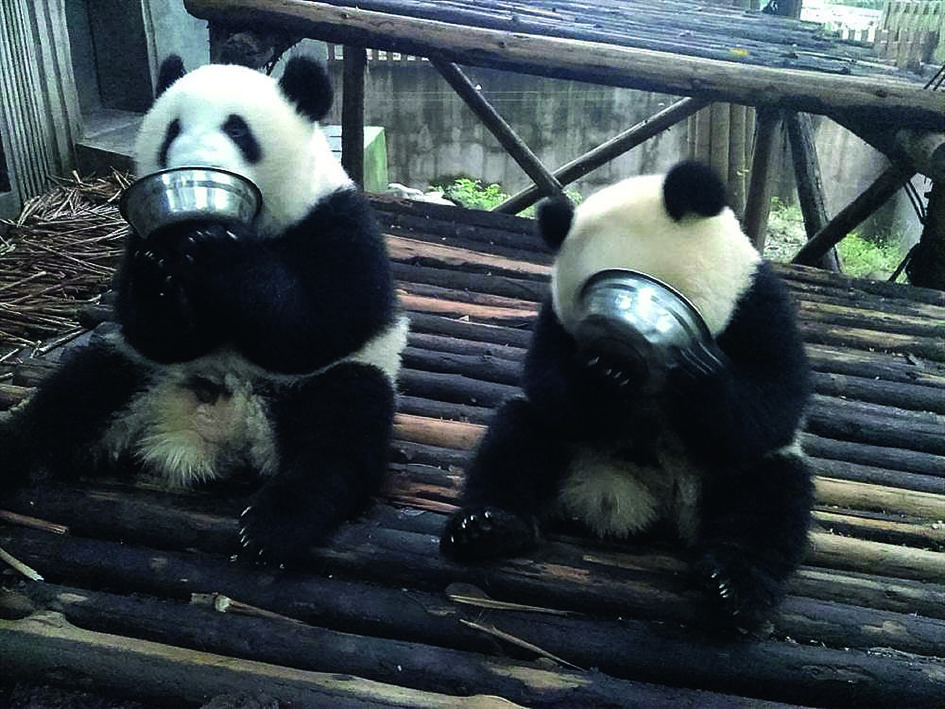In 2019 the giant pandas Mao Sun and He Xing are expected to arrive at Copenhagen Zoo.
Lucky number 15
Giant pandas only live in the wild in China, but have been lent to 14 zoos worldwide by now. But the giant panda is a species under threat, and synergy between the work of all the research centres and improving their natural habitat is essential.
At Chengdu Research Base they research and breed giant pandas, just as they do in other centres in the province of Sichuan and in two other provinces. Humans are the biggest threat to the animal’s population but at the same time, essential for their survival.
So cute
It’s a fantastic experience coming up close to real, live black and white giant pandas at the research centre that also functions as a zoo for the animals. It has become a great tourist attraction.
I managed to grab a place in the front row at an enclosure containing two pandas – perhaps a mother and her cub. The smaller panda appeared to be sleeping but the large one stood up, took a drink of water and strolled towards a little mound.
Here, she climbed up with quite some agility considering her size, selected a piece of bamboo, lay on her back and began to eat one of the day’s many meals.
Then the smaller one came lumbering over and I felt as though I’d witnessed a special moment between the two of them. Everything seemed to be slightly in slow motion and it was fascinating.
Eating non-stop
The research centre’s work is essential to save the giant panda, that is considered one of the most charming of the many endangered species in the world.
The giant panda has also become a symbol for endangered species in general because since 1961, the World Wildlife Fund has used it as its logo. Its chubby, cute appearance, with its distinctive black and white fur, pronounced black rings around its dark eyes and the fact that it can sit and lie just as we do, makes it look so sweet.
With its extra thumb or sesamoid bone it can grasp the bamboo tightly and peel the leaves off, and a panda’s day is more or less fully taken up with finding enough bamboo when it lives in the wild. Here, it is rather easier because they are of course fed using a special dietary scheme.
It takes many kilos of bamboo every day – around 45 for a fully-grown male. When they are not eating, they sleep – preferably up in a tree, where they seem to thrive lying on a couple of branches.
A need for space
There are a number of reasons why the existence of the giant panda is under threat.
Firstly, they need a lot of space – preferably around 10,000 square metres to find enough food, so they prefer to live alone. So it is necessary to build corridors in the forests that connect the bamboo thickets in the Chinese cloud forests, as they are called. They are found at a height of 1,500-3,500 metres spread over six mountain ranges in three provinces, in Sichuan as well as in Gansu and Shaanxi.
In addition, the female giant panda is only fertile for a couple of days a year and when the animals are so spread out, there is not always a male panda ready to breed in the neighbourhood. In that way, the chance may be missed for that year. In captivity they don’t necessarily feel like breeding at the same time and generally speaking, may have even less interest in breeding than they have in the wild. This has been observed in Chengdu and the other research centres.
A growing population
Attempts have been made to put males and females together who were both ready to breed but it has not always succeeded. After many tries, it has been decided to inseminate the females with sperm from different males. Gradually, the natural breeding program is becoming a success, leading to one panda cub being born every second year per female panda. The newborn cubs are incredibly small, only weigh around 100-200 grams and many don’t survive in the wild.
The giant panda population in China, which is the only place where they live wild, has in fact increased over the last few years and there are now around 2,200-2,500 in all. This is very much down to the work of the centres.
Giant pandas are something special and in Chinese culture, represent peace and harmony. Their calmness and black and white colours mirror the ying and yang, and its obvious cuteness factor has intensified interest in the animal and made it into a tourist attraction.















